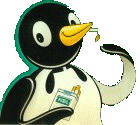 A Brief History of the KOOL
Penguin
A Brief History of the KOOL
Penguin|
The history of the KOOL penguin can be traced to October 1932, when the Brown and Williamson Tobacco Company is reported to have made the decision to market a mildly mentholated cigarette. 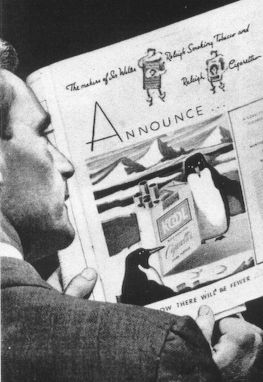
Once the name "KOOL" was selected, the advertising agency of Batten, Barton, Durstine and Osborn, Inc. developed an advertising campaign centered around the image of penguins. Apparently, seals and walruses were also considered. The ad shown at left is said to be the first of the KOOL magazine color pages. The text at the top states: "The makers of Sir Walter Raleigh Smoking Tobacco and Raleigh Cigarettes Announce...." 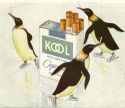
The idea of a "KOOL" penguin pre-dates the appearance of "Willie" the KOOL penguin. Indeed the penguin was referred to as "Mr. Kool," at least within the company and ad agency. The picture at left is from an advertisement in the December 9, 1933, issue of The Saturday Evening Post, the earliest KOOL penguin depiction presently residing in my collection.
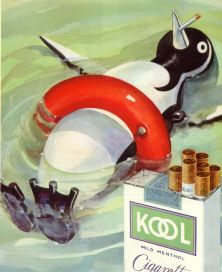
The early "Willie"-style illustrations were originally inspired by actual three-dimensional models carved in wood. Photographs of these wooden models, taken in the artist's workshop, are known to exist. But what about the models themselves? Now that would be the centerpiece of any KOOL penguin collection! Many of the early magazine ads appear to be reproduced from original watercolors, if not oil paintings. Some of them were done by an artist who signed the name "Rupprecht." Obviously, I would be pleased for someone to send me more information about all this. It is interesting to note that I have not seen a single example, among 33 different magazine advertisements, where the KOOL penguin is referred to by name. So when did Willie become "Willie"? Regrettably, I presently have more questions than answers. Certainly, the name was affixed by the mid-1940s when the set of salt and pepper shakers was first produced. I am guessing that the name "Willie" comes from the connection with the "Brown and Williamson" Tobacco Company. But when and by whom? Someone out there has the answers. DATING THE KOOL PENGUIN 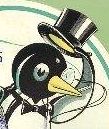

Over the years the KOOL penguin became more and more of a simple cartoon figure. In the early years he was not only more realistic, but also more formal, often appearing with a top hat and even a monocle. The less formal version is epitomized by the salt and pepper shakers. Near the end of his reign the rendering of the penguin (as seen in the television commercials) became so simple as to be somewhat unappealing. At least to my taste. 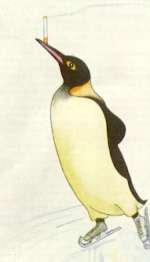
Most KOOL penguin collectibles are undated and, in the absence of definitive information from the ad agency's files, it is not easy to determine their age. An educated guess, however, may be made by examining the evolution of the penguin's image, comparing the different versions to known dates, and drawing conclusions accordingly. With this in mind, let's see how the KOOL penguin has changed over the years. The original KOOL penguin, circa 1933, was a quite realistic bird. He is not cartoonish in the least. Present evidence indicates that this version lasted no more than a year. 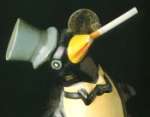
The second version is still quite realistic, although a bow tie, top hat, and monocle have been added. I have not seen this version in print. It may exist only in the form of the papier mache countertop figure and the large electric lighters. Accordingly, it is hard to place a date on it. Its origin would appear to be in the mid-'30s, but how long these figures were produced is unknown to me. 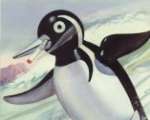
Beginning with the magazine ads of 1934, we see a cartoonish penguin, representing what some may regard as the "golden age" of this image. This version is distinguished by the stripe on the side of the head, which extends, in reverse, onto the chest. This version also has a white beak, rather than the original yellow beak. The penguin kept this same general appearance until about 1940. 
By 1940, the stripe has disappeared from the side of the penguin's head, but its remnant on the chest remains. Notice also that the beak has reverted from white back to yellow and is slightly elongated compared to later versions. 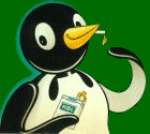
Over the years, the penguin's head and body became more and more distinct from each other. That is, he gets more of a neck. By the time we reach this fully cartoonish version of "Willie" his head has become very spherical, indeed. Also, the remnant of the "head stripe" has been transformed into a sort of "bow" or "string" tie. This is the KOOL penguin of the salt and pepper shaker era, also the classic image that appears at the top of this page. This version dates, roughly, to the period 1945 to 1955. 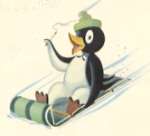
By the late 1950's, the image of the KOOL penguin has begun to decline. He is now too cartoonish, having lost much of his engaging charm and appeal. Many (if not most) images show him with an open beak and beady eyes. Also, what were previously remnants of a neck and head stripe have been fully transformed into a string tie. There you have it, a few guidelines to assigning an age to the various KOOL penguin collectibles. I must add, however, that this discussion represents a very inexact science. Certain KOOL penguin images may not fit into the scheme that I have described. In addition, certain images may have been reused during a later period, even though the "standard" penguin for that period had undergone a change. It is interesting how characters such as these commonly change over time, often losing characteristics, "attitude" if you will, that originally made them so appealing. Hey, the same thing happened to Mickey Mouse. Return to the "Willie" Penguin page. Return to the KOOL Penguin Collectibles page. This page created and maintained by Jim Lowe First appearance: October 2, 1997 Last updated: August 26, 1998 |
© 1997 and 1998 by James R. Lowe, who reserves all rights to the content of this page not successfully claimed by others.